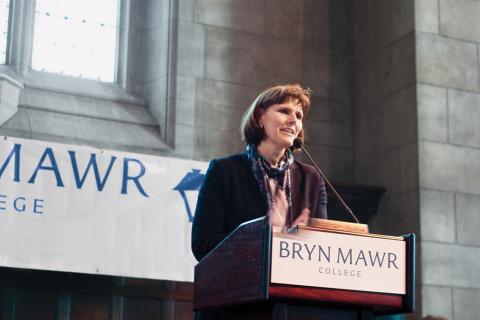The Great Enrollment Crash?
Our success has not been accidental.

Dear Friends: The headline story in a recent Chronicle of Higher Education commentary section was titled “The Great Enrollment Crash.” Accompanied by shorter essays by a variety of college and university enrollment leaders, the story explored the challenges presented by a demographic dip among traditional-age college students that continues through 2026 (especially in the Northeast and Midwest); the intersection of high college costs and stagnant family incomes; and changing student and family expectations of the goals of post-secondary education. As noted by these authors, we are already seeing evidence of this crash in the closure of a number of small, under-resourced colleges and in an increased number of institutions unable to meet their fall 2019 enrollment goals.
In large measure, this “crash” has not had an impact on highly selective institutions, and Bryn Mawr has been experiencing growing student interest. Applications grew 23 percent from 2014 to 2019, including a notable increase in the number of early decision applicants in the past two years. While we have become significantly more selective and have met—or significantly exceeded—our enrollment goals, we have at the same time maintained our commitment to diversity.
Our success has not been accidental. We continue to make changes in our recruiting practices and have invested strategically in programmatic innovation. For example, while Bryn Mawr has always had a national reach, our admissions staff is recruiting more intensively in selected metropolitan areas experiencing demographic growth. We have invested in a sophisticated, data-driven communications platform that allows the admissions staff to keep in touch with prospective students in a personalized way. And the College has been forward-looking in bringing innovative approaches to the core strengths of a liberal arts education—e.g., multidisciplinary course clusters, integrating classroom and field study, creating pathways to core digital competencies— that prospective students find compelling.
Outside forces have also unexpectedly benefited us. Extensive press coverage of gender disparities in the workplace have demonstrated to a new generation that the goal of gender equity has not yet been achieved. It has also prompted some young women who might not have considered a women’s college to explore that option.
We remain keenly aware of the complex challenges that face Bryn Mawr and other private liberal arts colleges, and we will continue our efforts to meet them. For example, we are conducting an extensive review of how we structure financial aid packages. This review seeks to address some of the financial strains experienced by students from middle-class families as well as lower-income ones, while being aware of fiscal constraints on the size of the College’s financial aid budget. We also need to respond to prospective students’ and families’ worries about post-graduate outcomes for graduates of liberal arts colleges.
Bryn Mawr has an ever stronger story to tell: In addition to evidence about long-term positive salary and career outcomes for all college graduates who pursue liberal arts majors (as reported in The New York Times on September 20), Bryn Mawr’s Career & Civic Engagement Center now provides our students with extensive resources to explore and build foundations for their professional future. We are learning, however, that we do need to communicate more effectively about this ROI.
I cannot close without acknowledging the important role of alumnae/i and friends in our recent success in making the case for Bryn Mawr. An increasing number of you have encouraged daughters, granddaughters, nieces, children of family friends, and even complete strangers to consider and to apply to Bryn Mawr. I send you our thanks for your advocacy and support, and a loud Anassa kata!
With best wishes,
Kim Cassidy, President
Published on: 11/15/2019
